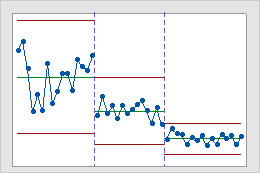Plotted points
The plotted points on the T chart are either the date/times of events, time between events, and the number of intervals between events, depending on the data in your worksheet.
Interpretation
If the process is in control, the points vary randomly around the center line, and the process exhibits only common-cause variation. Investigate points that fail any of the tests for special causes or that exhibit nonrandom patterns for possible special-cause variation.
Center line
The center line on the T chart is the 50th percentile of the distribution.
Interpretation
Use the center line to observe how the process performs compared to the average. If the process is in control, then the points vary randomly around the center line.
CAUTION
Do not confuse the center line with the target value for your process. The target is your desired outcome. The center line is the actual outcome.
Control limits
Control limits are the horizontal lines that are above and below the center line. The control limits indicate whether a process is out of control, and they are based on the probabilities for the standard normal distribution.
Tests for special causes
The tests for special causes assess whether the plotted points are randomly distributed within the control limits.
Interpretation
Use the tests for special causes to determine which observations you may need to investigate and to identify specific patterns and trends in your data. Each of the tests for special causes detects a specific pattern or trend in your data, which reveals a different aspect of process instability. For example, Test 1 detects a single out-of-control point. Test 2 detects a possible shift in the process.
For the traditional control charts for variables data, Tests 1, 5, 6, 7, and 8 are based on the normal distribution. However, for T charts, these tests are based on the Weibull distribution or the exponential distribution. For example, a point on a T chart fails Test 1 when the point is outside of the percentile range that correspond to 3 standard deviations from the mean for a normal distribution.
Eight tests are available with this control chart.
Stages
Use stages to create a historical control chart that shows how a process changes over specific periods of time. By default, Minitab recalculates the center line and control limits for each stage. For more information, go to Add stages to show how a process changed.
Interpretation
This historical control chart shows three stages of a process, which represent before, during, and after the implementation of a new procedure.

